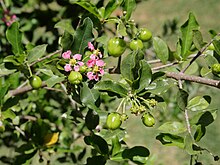| Malpighia emarginata | |
|---|---|

| |
| Close-up of the blossom and unripe fruit | |
| Scientific classification | |
| Kingdom: | Plantae |
| Clade: | Tracheophytes |
| Clade: | Angiosperms |
| Clade: | Eudicots |
| Clade: | Rosids |
| Order: | Malpighiales |
| Family: | Malpighiaceae |
| Genus: | Malpighia |
| Species: | M. emarginata
|
| Binomial name | |
| Malpighia emarginata | |
| Synonyms[1] | |
| |
| Nutritional value per 100 g (3.5 oz) | |||||||||||||||||||||||||||||||||||||||||||||
|---|---|---|---|---|---|---|---|---|---|---|---|---|---|---|---|---|---|---|---|---|---|---|---|---|---|---|---|---|---|---|---|---|---|---|---|---|---|---|---|---|---|---|---|---|---|
| Energy | 134 kJ (32 kcal) | ||||||||||||||||||||||||||||||||||||||||||||
7.69 g | |||||||||||||||||||||||||||||||||||||||||||||
| Dietary fiber | 1.1 g | ||||||||||||||||||||||||||||||||||||||||||||
0.3 g | |||||||||||||||||||||||||||||||||||||||||||||
0.4 g | |||||||||||||||||||||||||||||||||||||||||||||
| |||||||||||||||||||||||||||||||||||||||||||||
| Other constituents | Quantity | ||||||||||||||||||||||||||||||||||||||||||||
| Water | 91 g | ||||||||||||||||||||||||||||||||||||||||||||
| †Percentages estimated using US recommendations for adults,[2] except for potassium, which is estimated based on expert recommendation from the National Academies.[3] | |||||||||||||||||||||||||||||||||||||||||||||
Malpighia emarginata is a tropical fruit-bearing shrub or small tree in the family Malpighiaceae.
Common names include acerola (from Arabic: الزُّعرُورَة, romanized: az-zuʿrūra "azarole" for a similar looking old-world fruit[4]), Guarani cherry, Barbados cherry, West Indian cherry,[5] and wild crepe myrtle.[6] Acerola is native to Paraguay and Brazil in South America, Central America and southern Mexico, Puerto Rico, Dominican Republic and Haiti, but is now also being grown as far north as Texas and in subtropical areas of Asia, such as India.
- ^ "Malpighia emarginata DC. — The Plant List". www.theplantlist.org.
- ^ United States Food and Drug Administration (2024). "Daily Value on the Nutrition and Supplement Facts Labels". FDA. Archived from the original on 27 March 2024. Retrieved 28 March 2024.
- ^ National Academies of Sciences, Engineering, and Medicine; Health and Medicine Division; Food and Nutrition Board; Committee to Review the Dietary Reference Intakes for Sodium and Potassium (2019). Oria, Maria; Harrison, Meghan; Stallings, Virginia A. (eds.). Dietary Reference Intakes for Sodium and Potassium. The National Academies Collection: Reports funded by National Institutes of Health. Washington, DC: National Academies Press (US). ISBN 978-0-309-48834-1. PMID 30844154. Archived from the original on 9 May 2024. Retrieved 21 June 2024.
- ^ Ferreira, A. B. H. (1986). Novo Dicionário da Língua Portuguesa (second ed.). Rio de Janeiro: Nova Fronteira. p. 27.
- ^ Johnson, P.D. (2003). "Acerola (Malpighia glabra L., M. Punicifolia L., M. Emarginata D.C.): Agriculture, Production and Nutrition". Plants in Human Health and Nutrition Policy. World Review of Nutrition and Dietetics. Vol. 91. pp. 67–75. doi:10.1159/000069930. ISBN 978-3-8055-7554-6. PMID 12747089.
- ^ "Malpighia glabra L. wild crapemyrtle". PLANTS Database. United States Department of Agriculture. Archived from the original on 17 May 2006. Retrieved 17 October 2009.